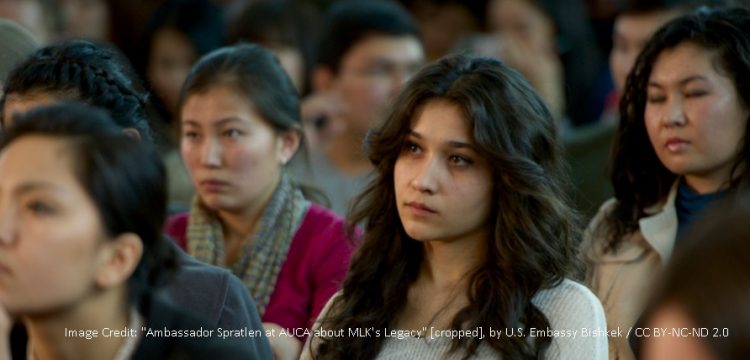Post-Taliban Afghan Women Embrace Educational Opportunities
Enakshi Sengupta
American University of Central Asia
“I remember my holidays in Kabul and how I had once shuddered seeing my cousins hiding their books under their veil going to a private school, their guilt ridden face showed as if they were stealing something, all they were doing was trying to educate themselves”, Maryam Haidary, 3rd year student , Business Administration, American University of Central Asia.
“We had to move to Mazhar e-Sharif, I lost two valuable years of my life as I was not allowed to attend a school, life was hard, very hard, we were struggling to have some basic amenities of life and education was one of them, we are glad that it is behind us,” Samira, 1st year student of Anthropology, American University of Central Asia.
Life is now different for Samira and Maryam, and others. They are the bright, young and vibrant students of AUCA whose eager faces shows their growing level of confidence and their new found happiness in being able to pursue higher education in the stream of their choice. These are the proud faces of Afghan girls who are studying at AUCA (www.auca.kg) in Kyrgyz Republic under US Embassy scholarships. They are proud of their country, their culture and their tradition, proud to be Afghan girls.
Some of them still remember the Taliban era when they were little girls, fleeing from Kabul and some still recounts the horror of that period. “The Taliban, who until their fall (late 2001) ruled nearly 90 percent of Afghanistan had imposed the darkest era for the education sector of the country. They had enforced a strict rule debarring women from education and confining the phenomenon for men within the realms of their own version of Islam”, (Zahirpour 2012 p. 18).
“The impact on women, especially in urban areas, was severe: 81% of women surveyed in Kabul reported a decline in their mental condition, 42% met the conditions for posttraumatic stress disorder (PTSD), and 21% said that they 'quite often' or 'very often' had suicidal thoughts” , Oxfam International, (Afghanistan, 2009).
Seventy percent of schools had undergone severe or partial damage, and the education sector of the country, along with other sectors, became the focal point of the international communities and aid agencies (Zahirpour 2012). The Ministry of Education (MoE) in Afghanistan along with other non-governmental agencies (NGO)’s and Aid Agencies started their strive to normalcy and education became a big part of their social reconstruction project. The United Nations Children's Fund (UNICEF), and the MoE, with the support of other related agencies implemented 'Back to School' campaign in 2002.
Gradually, schools started swarming with thousands of students and a high percentage of women students were once again attending their schools in pursuit of higher education. UNICEF delivered more than 7,000 tons of learning materials such as textbooks, notebooks, pencils, blackboards, chalks, school bags, tents, and other teaching and learning materials. According to the US State Department International Programmes Section, four million textbooks were parceled across Afghanistan. (Torpekai Sultani, The Current Situation of Basic Education in Afghanistan (nd), http://www.criced.tsukuba.ac.jp/pdf/04_Afghanistan_Sultani.pdf).
The United Nations Educational, Scientific and Cultural organization (UNESCO) committed its International Institute of Educational Planning (IIEP) to advise the ministry of education with necessary strategic planning and capacity development including training, research and technical assistance in the areas of policy formulation, as well as educational planning and management in relation to economic and social development to tackle the issue of education in Afghanistan (http://unesco.no/wp-content/uploads/2014/04/iiep-1.pdf, downloaded on 2nd May 2015).
Some of these projects gained financial support from a number of Scandinavian countries. Despite these global efforts, around 42 percent of children remain out of reach of school that constituted 4.5 million children. The main reasons for this are the rapid increase in the school age population, low MoE capacity, and lack of needed financial resources, (Ministry of Education NESP II (Kabul 2010-2014).
Another vital reason that kept the children away from attending schools especially the girl child was the prevailing sense of insecurity among them. According to a survey conducted by the United Nations, 300 schools in south Afghanistan were set on fire and a number of teachers were killed. (Afghanistan Online, “Girls Miss Out on Full Education”, Kabul, February 2007. www.afghan-web.com).
On the 24th and 27th May 2012, 100 and 40 female students respectively, were poisoned in provincial capital Taloqan (Takhar) (TOLO News, Ministry of Education Urges School Attackers to Stop, (Kabul 2012) http://tolonews.com/en/afghanistan/6345-ministry-of-education-urges-school-attackers-to-stop).
On the 15th May 2012, nearly 300 students were reported to have been poisoned in the Ismail Khil district of southern Khost Province. “Though there was no evidence whether the Taliban or the water in the school premises caused this incident, the case has not certainly been new in the country. Poisoning cases in Rustaq, Bamian, Kapisa and Ghazni have also been recorded”, (BBC Persian, http://www.bbc.co.uk/persian/afghanistan/2012/04/120423_k02-ghazni-schools-taleban.shtml).
The global community is determined to help the government of Afghanistan improve the plight of Afghan children and help them pursue higher education. The EducationUSA Opportunity Scholarship program funded by the U.S. Embassy is designed to increase access to U.S. higher education for highly qualified international students of limited means (http://kabul.usembassy.gov/eduusa.html). AUCA accepts applications for the Afghan Students Scholarship Program, funded by the US Embassy in Kabul. The program covers tuition fees, housing, and a stipend for selected students during all four years of undergraduate study at AUCA, in addition to a one year preparatory program (https://auca.kg/en/p22267000/).
The Indian government also offers around 1,000 scholarships every year to the Afghan students, which is sponsored by the Indian Council for Cultural Relations (ICCR). The ICCR scholarship scheme for Afghanistan was launched in 2005. At present, the Afghan students are pursuing courses in international studies, economics, bachelors' degrees, bachelors in technology and many more programmes in various universities across India (http://www.business-standard.com/article/news-ani/india-offers-scholarship-to-afghan-students-114113000168_1.html).
“The Afghanistan Millennium Development Goals (AMDG) targets 100 percent enrolment for primary education. Based on the current demography, around 8.8 million children are likely to require access to primary education by 2020”, (Zahirpour 2012, p. 43.). While appreciating and understanding the overall efforts of the international partners and that of the Afghanistan's ministry of education in literacy enhancement projects, it is quite evident that much more is required to be done to uplift the standard of education in Afghanistan (Zahirpour 2012). As of now Maryam, Samira and others like them are happy to be the lucky few who are sailing on their path to realize their dreams, unthinkable less than a decade ago.
References:
Afghanistan Online, “Girls Miss Out on Full Education”, Kabul, February 2007. www.afghan-web.com.
American University of Central Asia. https://auca.kg/en/p22267000/, downloaded on 2nd May 2015.
BBC Persian, http://www.bbc.co.uk/persian/afghanistan/2012/04/120423_k02-ghazni-schools-taleban.shtml, retrieved on 29th April, 2015
http://www.business-standard.com/article/news-ani/india-offers-scholarship-to-afghan-students-114113000168_1.html, downloaded on 2nd May, 2015.
Ministry of Education NESP II (Kabul 2010-2014)
Oxfam International, Afghanistan. 2009.
TOLO News, Ministry of Education Urges School Attackers to Stop, (Kabul 2012) http://tolonews.com/en/afghanistan/6345-ministry-of-education-urges-school-attackers-to-stop.
Torpekai, S. The Current Situation of Basic Education in Afghanistan (nd), http://www.criced.tsukuba.ac.jp/pdf/04_Afghanistan_Sultani.pdf.
U.S. Embassy, Kabul. http://kabul.usembassy.gov/eduusa.html, downloaded on 2nd May 2015.
Zahirpour, A. (2012). The state of public education in Afghanistan. Political problems, and future prospects. Vivekananda International Foundation.
Suggested Citation:
Sengupta, E. (2015). Post-Taliban Afghan Women Embrace Educational Opportunities. Higher Education Tomorrow, Volume 2, Article 4, https://www.patrickblessinger.com/post-taliban-afghan-women-embrace-educational-opportunities
Copyright © [2015] Enakshi Sengupta
Disclaimer:
Opinions expressed in this article are those of the author, and as such, do not necessarily represent the position(s) of other professionals or any institution.








Comments are off this post